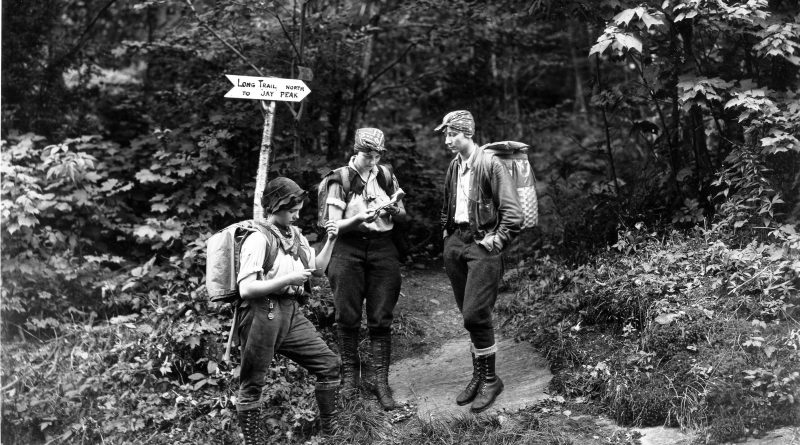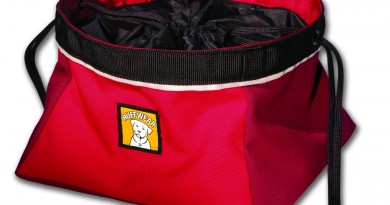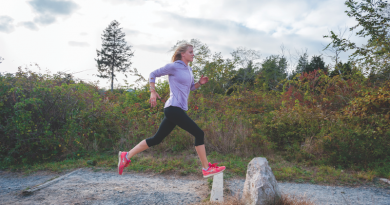A Backpacking (R)Evolution
If you’ve ever been on a multi-day hike on the Long Trail, there’s a good chance you’ve given thanks, at some point, for modern gear: Bug spray, steady packs, a waterproof tent, your cookware–it’s all relatively lightweight and convenient. And this year, thanks new technology and the modern man’s never-ending quest to be efficient, it could be even better and lighter, as you’ll see from our gear picks on the following pages.
But what about people who set the trails through the Green Mountains 100 years ago? For them, the Long Trail Guidebook, first published by the Green Mountain Club in 1917, was the source of advice on what to bring: “Heavy, high shoes will be found easiest on an all day’s hike. Any of several makes of knapsacks will carry all that one really needs.”
This summer, knickers and leather boots made a come-back on the Long Trail. In celebration of the Long Trail Guide’s centennial edition, Mike DeBonis, president of the Green Mountain Club, hiked the trail in retro style. Carrying the 1917 guidebook, he followed much of the original advice, packing bread, cheese, bacon and canned fish. He waterproofed a cotton sheet to make a tarp and even wove his own pack from ash splints he carved himself.
“This is fashioned after the style of the Adirondack pack basket,” he said as he showed his pack off at a trail pit-stop along the Winooski last July. “I put socks on the handles. One of the challenges I had was that the leather was cutting in [to my shoulders], and I needed to have some additional padding. People were way tougher back then than I am now, that’s for sure,” he said. “One thing I’ve learned is that modern gear is amazing. It makes the trail so much more accessible.”
The 1917 Long Trail Guide recommended that men wear “Shoes with hobnails, felt hat, ‘generous sized’ silk bandana, inch-wide leather belt with cup attached, wool underwear, wool shirt and stout wool trousers.” For women? High, laced leather boots with “Hungarian nails,” and wool bloomers.
“Upstairs, downstairs, all wool,” DeBonis said, “which is good, but on those 90-degree days, it can be a little warm.” He does admit to using modern wool though, and wore under layers from Ibex.
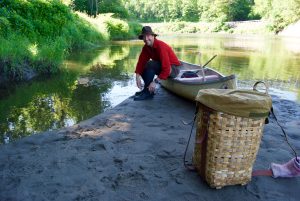
The Long Trail—envisioned by James P. Taylor, headmaster of the Vermont Academy for Boys at Saxton’s River—was officially born in 1910 (10 years earlier than the Appalachian Trail) after Taylor and 22 others gathered in Burlington to found the Green Mountain Club. By 1917, the first guidebook was published, and by 1920, 209 miles of trails had been completed, running from Johnson south to the Massachusetts border. The goal, stated by the newly-minted GMC, was to “make the Vermont Mountains play a larger part in the life of people.”
With 700 members in the first decade, the Green Mountain Club was reaching its goal, and it kept growing. Ten years later, during the summer of 1927, the trail was made famous by “The Three Musketeers,” three women, Hilda Kurth (25 at the time), Catherine Robbins (also 25), and Kathleen Norris (18) who took on the task of hiking the entirety of the Long Trail, unaccompanied by male figures—a daring feat, back in the day.
The women were an overnight media sensation, covered by every local newspaper, all of whom printed photos of their knickers, lace-up boots and bandanas. The Vermont Historical Society later interviewed Robbins, who talks about a surprise that GMC president Taylor arranged for the women.
“I heard someone yell, ‘Yoohoo!’” Robbins said. “There was a perfectly civilized man in white slacks and a white jacket, and he said, ‘I’m looking for the Three Musketeers! Come on down, I have a gallon of ice cream for you.’ Boy, did I go down that mountain fast, and sure enough, they had a whole gallon of ice cream. We ate it all up. It was terrific.”
Two years later, by 1928, the Guide had updated its recommendations.
“Of all the personal equipment, the most important is good shoes. They should be broken in, loose, and well oiled. Munson last army shoes are advised, better yet in all weathers, if hobnailed,” it reads. And, to the relief of women everywhere: “Women should not wear skirts, even divided skirts; riding breeches are advised, of khaki or close-woven material.”
So what’s changed? The short answer: everything. Enter Chris Reamer, Outdoor Gear Exchange’s backpacking expert who has hiked the Appalachian Trail and the Long Trail several times over. He sports a Gandolf-sized beard and if he had a slogan, it might be, “there’s a pack for that.” This year there’s even more cool gear than ever. We stopped by the Church Street store to see what he’d recommend.
Reamer pulled a white pack off the shelves. The Hyperlite Mountain Gear Windrider weighs in at just 28.2 oz. It looks like it’s made out of parchment paper, and it’s handmade in Maine.
“My girlfriend and I are planning on doing the Pacfic Crest Trail next year, and the key out there is doing it as light as possible, so this is the pack I’ll use.” he said. “This pack isn’t going to work well with a heavy load. With a pack like this, your base weight–which is everything you’re going to carry minus food, fuel and water–ideally would be sub-ten pounds.”
Reamer walks around the store, pointing to ultra-light or ultra-comfortable gear that modern day hikers can use to make the Long Trail more enjoyable. There are roomy tents that weigh less than two pounds, sleeping bags for every condition, camp chairs that stretch to be love-seat-sized, queen-sized sleeping pads, bowls, pots and sporks that all fit inside each other.
Above (and on the following pages), Reamer suggests the ultimate gear packages for ultra-light hikers and minimalists and for weekend warriors who care about creature comforts. There’s everything you need for the trail… except ice cream.
THE MINIMALISTS
There are plenty of reasons to go ultra-light while backpacking. Maybe you’re planning to run up to one of the Long Trail lean-tos for the night and then run back down. Maybe you’re hitting up some of New Hampshire’s 4,000-footers and don’t want to be bogged down by extra weight. Maybe you just want to see how minimalist you can be. If that’s your thing, you could pack everything below (including pack, tent, shoes and three meals) and it wouldn’t add up to more than 7 lbs. That’s nearly a third of the weight (18 lbs) of all the gear in the Weekend Warrior section (which follows).
For a pack, Reamer recommends the Hyperlite Mountain Gear Windrider ($300), 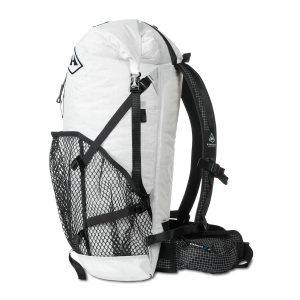 Handmade in Maine and just 1.76 pounds, it won’t add much to your base weight, and the tarpish, waxy, 100-percent waterproof material, made from Dyneema® Composite Fabrics, is more durable than it looks. The bag is completely zipper-less; three black mesh pockets on the exterior give you easy access and allow gear to dry quickly. Its roll-top closure system helps you compress the pack down vertically, and straps on the side and top help secure your gear and compress the pack even more.
Handmade in Maine and just 1.76 pounds, it won’t add much to your base weight, and the tarpish, waxy, 100-percent waterproof material, made from Dyneema® Composite Fabrics, is more durable than it looks. The bag is completely zipper-less; three black mesh pockets on the exterior give you easy access and allow gear to dry quickly. Its roll-top closure system helps you compress the pack down vertically, and straps on the side and top help secure your gear and compress the pack even more.
The tried and true dogma of ultralight hikers is this: bring multi-purpose equipment. At 1 pound 6 oz, the two-person MSR Flylite Tent ($350) uses your trekking poles as tent poles, and even leaves plenty of room for you and a buddy. Mesh vents in the sides and back of the tent keep condensation under control, and the wide-reaching rain fly gives plenty of space to store muddy or wet gear.
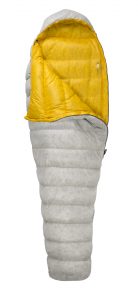 For your own personal shelter (the sleeping bag), the Spark SP II ($379) from Sea to Summit weighs in at just over a pound. Its contoured mummy design packs down to the size of a football. The bag is filled with 850+ goose down, which will keep you warm through temperatures as low as 35 degrees, so perhaps not the best choice for colder weather, but great if you are staying in a hut. You can lay that bag down on the Thermarest Neoair Xlite sleeping pad ($159.95), whose patent-pending “triangular core matrix” provides structure and reflects your body heat back to you, all in a packable 8 oz. 1
For your own personal shelter (the sleeping bag), the Spark SP II ($379) from Sea to Summit weighs in at just over a pound. Its contoured mummy design packs down to the size of a football. The bag is filled with 850+ goose down, which will keep you warm through temperatures as low as 35 degrees, so perhaps not the best choice for colder weather, but great if you are staying in a hut. You can lay that bag down on the Thermarest Neoair Xlite sleeping pad ($159.95), whose patent-pending “triangular core matrix” provides structure and reflects your body heat back to you, all in a packable 8 oz. 1
To keep cookware light, try out the MSR Pocket Rocket ($44.95). Lighter (2.6 oz) and smaller than the original, this little guy can boil a liter of water in 3.5 minutes. (Though you may want to carry a bit of extra fuel along–the rocket can burn out your tank a bit faster than the average stove.) The difference between this stove and other small tripods? The pot supports fold down to to the size of a pocket knife.
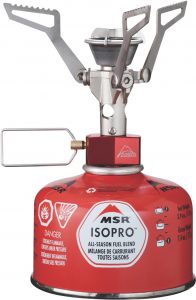
As for food, there are a thousand ultra lightweight dried meals you can bring along, but our favorite is Mountain House ($9). With options that range from beef stew to chicken with dumplings (4.6 oz and 15 grams of protein) and macaroni and cheese, the meals are filling, light and conveniently packed in bags. Just add hot water to, reseal to cook, and then eat from the bag. No dishes!
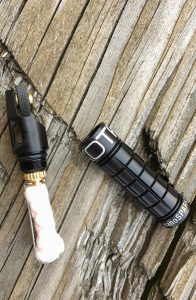 To get your fire started, the Exotac NanoSpark Lighter ($26.95) at about half an ounce, adds almost nothing to your weight or space. About the size of your pinky, the flint-based sparker (read: no fuel) has a waterproof compartment to carry the quickLight tinder abs that come with the lighter. Like the E+Lite, it should be part of any emergency kit.
To get your fire started, the Exotac NanoSpark Lighter ($26.95) at about half an ounce, adds almost nothing to your weight or space. About the size of your pinky, the flint-based sparker (read: no fuel) has a waterproof compartment to carry the quickLight tinder abs that come with the lighter. Like the E+Lite, it should be part of any emergency kit.
For a through-and-through ultralight setup, your gear should fit the bill from head to toe. Scarpa Spin alpine running shoes ($130) have a low-profile design and weigh in at 8.9 oz. While you might want higher ankle boots for a long trek, the Vibram 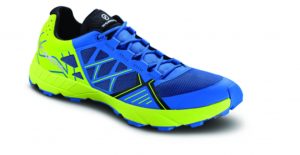 outsoles are perfect for running between peaks, and the high-density rock plate will make sure you’re not stubbed by any sharp surprises on the trail. Pair those with set of Farm to Feet Damascus ($22.50) hiking socks–made in the USA with all-American Merino wool for a lightweight blend of ventilation, moisture management and odor resistance.
outsoles are perfect for running between peaks, and the high-density rock plate will make sure you’re not stubbed by any sharp surprises on the trail. Pair those with set of Farm to Feet Damascus ($22.50) hiking socks–made in the USA with all-American Merino wool for a lightweight blend of ventilation, moisture management and odor resistance.
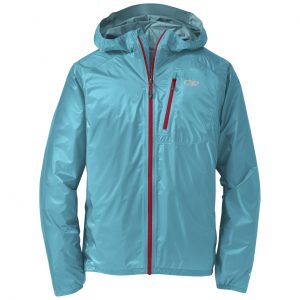 If you’re hiking in Vermont, a rain jacket is non-negotiable. Luckily, the Outdoor Research Helium II Rain Shell ($159) is 6.4 oz and packs down to the size of a pack of Ramen noodles. It’s windproof and includes a Pertex 2.5-layer of waterproof breathable laminate.
If you’re hiking in Vermont, a rain jacket is non-negotiable. Luckily, the Outdoor Research Helium II Rain Shell ($159) is 6.4 oz and packs down to the size of a pack of Ramen noodles. It’s windproof and includes a Pertex 2.5-layer of waterproof breathable laminate.
The Petzl E+Lite headlamp ($29.95) belongs in your pack, day or night, as an emergency light. Including batteries (at max power it has 9 hours of battery life), it weighs a single ounce and has two brightness levels (and shines at 50 lumens), so you can read–that is, if you allowed yourself the luxury of bringing the guidebook.
THE WEEKEND WARRIOR
If you’re headed out on the trail for a long weekend, or plan to do some canoe-camping/hiking, you still care about weight. But you also care about comfort and durability. We asked Reamer, as well as other experts, what they’d choose for a weekend away.
To start with, if you want to carry more gear, you will need a larger pack and one that will be comfortable under a load. After testing lighter and cheaper packs, we still like the Gregory Baltoro 65 (women’s version is the Deva 60) for multi-day hikes, and the 2017 model shaves 0.9 ounces off its predecessor. While it’s weight (5.1 lbs) and price ($299) may seem like they could break your back or your bank, the sturdiness of the fabric, the comfort and the practicality made this a favorite. The pack just feels like it molds to your body with cushy but sturdy shoulder and hip straps that hold the weight in place. Features that we love: the hydration sleeve turns into a daypack, there are a total of 8 pockets (including one on the waist belt for a small phone or camera) and the super easy access pockets, including two zippers on the lid.
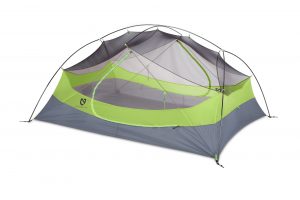 Even if you are just two, opting for a 3-person tent makes camping a lot more comfortable. Nemo’s Dagger 3 ($499.95) weight in at just at 4 lb. 4 ozs and packs down nicely. It’s a relatively roomy 43-square-foot floor with a 42-inch peak and doesn’t taper so you can sleep either direction, easily, and the “light pocket” (put your headlamp in it) at the peak is a great touch. Most important, the lightweight 20 and 30-denier nylon fabric is bulletproof, justifying it’s price. One of our testers slept in it soundly, without feeling a drop of moisture, through the thunder and torrential rainstorm that earned Vermont FEMA relief money over July 4 weekend. Lay down the Nemo Tensor Insulated Air Pad ($149-$169) which is superlight (19 oz minimum weight) and comes with 3 inches of cushioning and Primaloft insulation. The pads come in a variety of sizes, the smallest of which rolls up to the size of a waterbottle.
Even if you are just two, opting for a 3-person tent makes camping a lot more comfortable. Nemo’s Dagger 3 ($499.95) weight in at just at 4 lb. 4 ozs and packs down nicely. It’s a relatively roomy 43-square-foot floor with a 42-inch peak and doesn’t taper so you can sleep either direction, easily, and the “light pocket” (put your headlamp in it) at the peak is a great touch. Most important, the lightweight 20 and 30-denier nylon fabric is bulletproof, justifying it’s price. One of our testers slept in it soundly, without feeling a drop of moisture, through the thunder and torrential rainstorm that earned Vermont FEMA relief money over July 4 weekend. Lay down the Nemo Tensor Insulated Air Pad ($149-$169) which is superlight (19 oz minimum weight) and comes with 3 inches of cushioning and Primaloft insulation. The pads come in a variety of sizes, the smallest of which rolls up to the size of a waterbottle.
For a sleeping bag, we like to have our bases covered. Kammock’s Thycaline ($229-$528) is a two-in-one bag. The outer base bag (just 16 oz if you go with down) is a roomy bag, perfect for early fall, 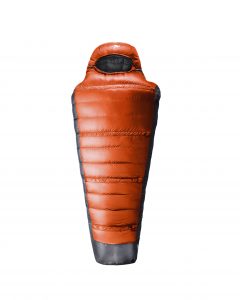 when temperatures don’t drop below freezing. And for winter camping (or if you’re climbing above snowline) there’s a down liner insert that will take you down to 0 degrees. The bag comes with down or synthetic fill options and cinch cords help you adjust the fit.
when temperatures don’t drop below freezing. And for winter camping (or if you’re climbing above snowline) there’s a down liner insert that will take you down to 0 degrees. The bag comes with down or synthetic fill options and cinch cords help you adjust the fit.
If you’re going light, you could get away camping with just a 14-oz. JetBoil Mini Mo stove ($134.95)—where the burner, stand, canister support and 100-gram fuel canister can all snap together and pack into a cookpot that’s the size of a coffee can. Or you can also bring along the new GSI Glacier Stainless Fry Pan ($34.95). At 23.8 oz, it’s more for canoe or car camping but the 10-inch fry pan (or 8-inch) has a folding handle and its non-stick stainless steel (aluminum core) has a non-stick surface that works surprisingly well.
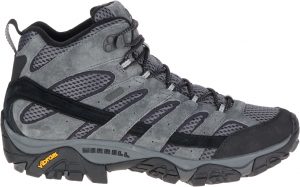 How you outfit yourself is just as important as what you pack. The Merrell Moab 2 Mid WP ($150), or lower shoe with the GoreTex membrane (WP stands for waterproof), is a tried and true and slightly improved for 2017. It’s not the shoe you’ll use for a through-hike in the Rockies with a heavy pack but its supportive arch, improved heel cushioning and Vibram sole are good for weekend trips. There’s no question about which sock: Vermont-made Darn Tough has fast become the distance hiking standard and the new wool-blend Darn Tough Switchback ($20) is boot height, seamless and features light cushioning. Like all Darn Tough socks, it’s guaranteed for life.
How you outfit yourself is just as important as what you pack. The Merrell Moab 2 Mid WP ($150), or lower shoe with the GoreTex membrane (WP stands for waterproof), is a tried and true and slightly improved for 2017. It’s not the shoe you’ll use for a through-hike in the Rockies with a heavy pack but its supportive arch, improved heel cushioning and Vibram sole are good for weekend trips. There’s no question about which sock: Vermont-made Darn Tough has fast become the distance hiking standard and the new wool-blend Darn Tough Switchback ($20) is boot height, seamless and features light cushioning. Like all Darn Tough socks, it’s guaranteed for life.
Up top, the Arc’teryx Atom SL Hoody ($229) is great for those days when it starts out warm on the trail but the time you reach the krummholz, you need to break out another layer. The Coreloft™ Compact 40g insulation is ultralight and breathable. Even better, it squishes down to a little ball you can easily stuff in the lid of a pack and the outer layer is windproof and sheds water. It’s also stretchy enough to give a full range of movement if you’re, say, climbing ladders on the Long Trail but has a low-profile so it could layer beneath a heavier shell.
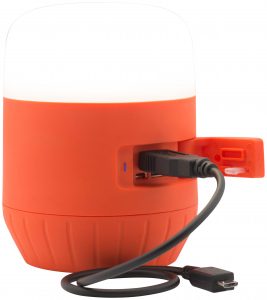 We love the new generation of rechargeable headlamps, and Black Diamond’s Revolt ($59.95) beams out 300 lumens and it’s waterproof. Better yet, it uses either standard alkaline or lithium batteries or its own rechargeable AAAs. It can recharge off anything from a cigarette lighter to a USB port and, get this, has a meter that shows how much battery power is left. And you can charge it with your Black Diamond Moji Charging Station Lantern ($79.95) which has enough juice to give you 50 hours of power, 250 lumens of light and can charge up your cell phone, too.
We love the new generation of rechargeable headlamps, and Black Diamond’s Revolt ($59.95) beams out 300 lumens and it’s waterproof. Better yet, it uses either standard alkaline or lithium batteries or its own rechargeable AAAs. It can recharge off anything from a cigarette lighter to a USB port and, get this, has a meter that shows how much battery power is left. And you can charge it with your Black Diamond Moji Charging Station Lantern ($79.95) which has enough juice to give you 50 hours of power, 250 lumens of light and can charge up your cell phone, too.

